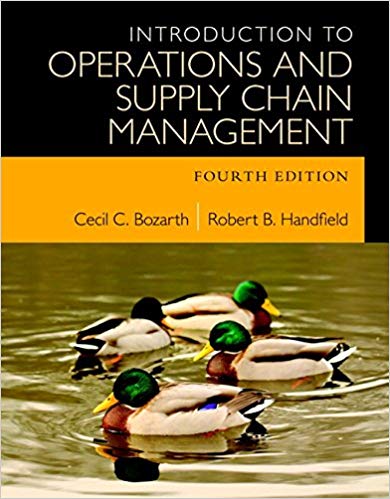Solution manual for Introduction to Operations and Supply Chain Management 4th edition by Cecil Bozarth,Robert Handfield 0133871770 9780133871777
$70.00 Original price was: $70.00.$35.00Current price is: $35.00.
Instant download (Solution manual) Introduction to Operations and Supply Chain Management 5th by Cecil B. Bozarth (Author) Robert B. Handfield (Author) after payment
Solution manual for Introduction to Operations and Supply Chain Management 4th edition by Cecil Bozarth,Robert Handfield – Ebook PDF Instant Download/Delivery:0133871770 ,9780133871777
Full dowload Introduction to Operations and Supply Chain Management 4th edition after payment
Product details:
ISBN 10:0133871770
ISBN 13:978-0133871777
Author:Cecil Bozarth,Robert Handfield
Managementis an integrated, comprehensive introduction to both Operations and Supply chain management topics. The text remains engaging and brief while integrating all of the major concepts of both subjects in one cohesive source.
The Fourth Edition contains updated chapter content and thorough coverage of analytical tools and techniques that apply to Operations and Supply Chain Management. Introduction to Operations and Supply Chain Management explores two essential, introductory business subjects in an interesting and relatable manner by providing students with real world examples and easy-to-understand material.
Introduction to Operations and Supply Chain Management 4th Table of contents:
PART I Creating Value through operations and supply Chains
Chapter 1 Introduction to operations and supply Chain management
Introduction
1.1 Why Study Operations and Supply Chain Management?
Operations Management
Supply Chain Management
1.2 Important Trends
Electronic Commerce
Increasing Competition and Globalization
Relationship Management
1.3 Operations and Supply Chain Management and You
Professional Organizations
Cross-Functional and Interorganizational Linkages
1.4 Purpose and Organization of This Book
Chapter Summary
Key Terms
Discussion Questions
Problems
Case Study
References
Chapter 2 Operations and supply Chain strategies
Introduction
2.1 Elements of the Business
2.2 Strategy
2.3 Operations and Supply Chain Strategies
Customer Value
Four Performance Dimensions
Trade-Offs among Performance Dimensions
Order Winners and Order Qualifiers
Stages of Alignment with the Business Strategy
Core Competencies in Operations and Supply Chains
Chapter Summary
Key Formula
Key Terms
Solved Problem
Discussion Questions
Problems
Case Study
References
PART II
Establishing the operations environment
Chapter 3 Process Choice and layout decisions in manufacturing and services
Introduction
3.1 Manufacturing Processes
Production Lines and Continuous Flow Manufacturing
Job Shops
Batch Manufacturing
Fixed-Position Layout
Hybrid Manufacturing Processes
Linking Manufacturing Processes across the Supply Chain
Selecting a Manufacturing Process
The Product-Process Matrix
3.2 Product Customization within the Supply Chain
Four Levels of Customization
The Customization Point
3.3 Service Processes
Service Packages
Service Customization
Customer Contact
Service Positioning
Services within the Supply Chain
3.4 Layout Decision Models
Line Balancing
Assigning Department Locations in Functional Layouts
Chapter Summary
Key Formulas
Key Terms
Solved Problem
Discussion Questions
Problems
Case Study
References
Chapter 4 Business Processes
Introduction
4.1 Business Processes
Improving Business Processes
4.2 Mapping Business Processes
Process Maps
Swim Lane Process Maps
4.3 Managing and Improving Business Processes
Measuring Business Process Performance
Productivity
Efficiency
Cycle Time
Benchmarking
The Six Sigma Methodology
Continuous Improvement Tools
4.4 Business Process Challenges and the SCOR Model
How Standardized Should Processes Be?
Business Process Reengineering
Coordinating Process Management Efforts across the Supply Chain
The SCOR Model
Chapter Summary
Key Formulas
Key Terms
Solved Problem
Discussion Questions
Problems
Case Study
References
Chapter 5 Managing Quality
Introduction
5.1 Quality Defined
5.2 Total Cost of Quality
5.3 Total Quality Management
TQM and the Six Sigma Methodology
5.4 Statistical Quality Control
Process Capability
Six Sigma Quality
Control Charts
Acceptance Sampling
Taguchi’s Quality Loss Function
5.5 Managing Quality across the Supply Chain
ISO 9000 Family
External Failures in the Supply Chain
Chapter Summary
Key Formulas
Key Terms
Using Excel in Quality Management
Solved Problem
Discussion Questions
Problems
Case Study
References
Chapter 6 Managing Capacity
Introduction
6.1 Capacity
Measures of Capacity
Factors That Affect Capacity
Supply Chain Considerations
6.2 Three Common Capacity Strategies
6.3 Methods of Evaluating Capacity Alternatives
Cost
Demand Considerations
Expected Value
Decision Trees
Break-Even Analysis
Learning Curves
Other Considerations
6.4 Understanding and Analyzing Process Capacity
The Theory of Constraints
Waiting Line Theory
Little’s Law
Chapter Summary
Key Formulas
Key Terms
Using Excel in Capacity Management
Solved Problem
Discussion Questions
Problems
Case Study
References
Chapter 6s Advanced Waiting line theory and simulation modeling
Introduction
6S.1 Alternative Waiting Lines
Assumptions behind Waiting Line Theory
Waiting Line Formulas for Three Different Environments
6S.1 Simulation Modeling
Monte Carlo Simulation
Building and Evaluating Simulation Models with SimQuick
Supplement Summary
Discussion Questions
Problems
References
PART III Establishing supply Chain linkages
Chapter 7 Supply Management
Introduction
7.1 Why Supply Management Is Critical
Global Sourcing
Financial Impact
Performance Impact
7.2 The Strategic Sourcing Process
Step 1: Assess Opportunities
Step 2: Profile Internally and Externally
Step 3: Develop the Sourcing Strategy
Step 4: Screen Suppliers and Create Selection Criteria
Step 5: Conduct Supplier Selection
Step 6: Negotiate and Implement Agreements
7.3 The Procure-to-Pay Cycle
Ordering
Follow-Up and Expediting
Receipt and Inspection
Settlement and Payment
Records Maintenance
7.4 Trends in Supply Management
Sustainable Supply
Supply Chain Disruptions
Chapter Summary
Key Formulas
Key Terms
Solved Problem
Discussion Questions
Problems
Case Study
References
Chapter 8 Logistics
Introduction
8.1 Why Logistics Is Critical
8.2 Logistics Decision Areas
Transportation
Selecting a Transportation Mode
Multimodal Solutions
Warehousing
Logistics Information Systems
Material Handling and Packaging
Inventory Management
8.3 Logistics Strategy
Owning versus Outsourcing
Measuring Logistics Performance
Landed Costs
Reverse Logistics Systems
8.4 Logistics Decision Models
Weighted Center of Gravity Method
Optimization Models
The Assignment Problem
Chapter Summary
Key Formulas
Key Terms
Solved Problem
Discussion Questions
Problems
Case Study
References
PART IV Planning and Controlling operations and supply Chains
Chapter 9 Forecasting
Introduction
9.1 Forecast Types
Demand Forecasts
Supply Forecasts
Price Forecasts
9.2 Laws of Forecasting
Law 1: Forecasts Are Almost Always Wrong (But They Are Still Useful)
Law 2: Forecasts for the Near Term Tend to Be More Accurate
Law 3: Forecasts for Groups of Products or Services Tend to Be More Accurate
Law 4: Forecasts Are No Substitute for Calculated Values
9.3 Selecting a Forecasting Method
9.4 Qualitative Forecasting Methods
9.5 Time Series Forecasting Models
Last Period
Moving Average
Weighted Moving Average
Exponential Smoothing
Adjusted Exponential Smoothing
Linear Regression
Seasonal Adjustments
9.6 Causal Forecasting Models
Linear Regression
Multiple Regression
9.7 Measures of Forecast Accuracy
9.8 Computer-Based Forecasting Packages
9.9 Collaborative Planning, Forecasting, and Replenishment (CPFR)
Chapter Summary
Key Formulas
Key Terms
Solved Problem
Discussion Questions
Problems
Case Study
References
Chapter 10 Sales and operations Planning (aggregate Planning)
Introduction
10.1 S&OP in the Planning Cycle
10.2 Major Approaches to S&OP
Top-Down Planning
Level, Chase, and Mixed Production Plans
Bottom-Up Planning
Cash Flow Analysis
10.3 Organizing for and Implementing S&OP
Choosing between Alternative Plans
Rolling Planning Horizons
Implementing S&OP in an Organization
10.4 Services Considerations
Making Sales Match Capacity
Making Capacity Match Sales
10.5 Linking S&OP throughout the Supply Chain
10.6 Applying Optimization Modeling to S&OP
Chapter Summary
Key Formulas
Key Terms
Solved Problem
Discussion Questions
Problems
Case Study
References
Chapter 11 Managing inventory throughout the supply Chain
Introduction
11.1 The Role of Inventory
Inventory Types
Inventory Drivers
Independent versus Dependent Demand Inventory
11.2 Periodic Review Systems
Restocking Levels
11.3 Continuous Review Systems
The Economic Order Quantity (EOQ)
Reorder Points and Safety Stock
Quantity Discounts
11.4 Single-Period Inventory Systems
Target Service Level
Target Stocking Point
11.5 Inventory in the Supply Chain
The Bullwhip Effect
Inventory Positioning
Transportation, Packaging, and Material Handling Considerations
Chapter Summary
Key Formulas
Key Terms
Using Excel in Inventory Management
Solved Problems
Discussion Questions
Problems
Case Study
References
Chapter 12 Managing Production across the supply Chain
Introduction
12.1 Master Scheduling
The Master Schedule Record
Using the Master Schedule
12.2 Material Requirements Planning
The MRP Record
The Advantages of MRP
Special Considerations in MRP
12.3 Production Activity Control and Vendor Order Management Systems
Job Sequencing
Monitoring and Tracking Technologies
12.4 Synchronizing Planning and Control across the Supply Chain
Distribution Requirements Planning
Chapter Summary
Key Formulas
Key Terms
Solved Problem
Discussion Questions
Problems
Case Study
References
Chapter 12s supply Chain information systems
Introduction
12S.1 Understanding Supply Chain Information Needs
Differences across Organizational Levels
Direction of Linkages
12S.2 Supply Chain Information Systems
12S.3 Trends to Watch
BPM Tools
Cloud Computing
Supplement Summary
Key Terms
Discussion Questions
References
Chapter 13 jit/lean Production
Introduction
13.1 The Lean Perspective on Waste
13.2 The Lean Perspective on Inventory
13.3 Recent Developments in Lean Thinking
13.4 Kanban Systems
Controlling Inventory Levels Using Kanbans
Synchronizing the Supply Chain Using Kanbans
Using MRP and Kanban Together
Chapter Summary
Key Formula
Key Terms
Solved Problem
Discussion Questions
Problems
Case Study
References
PART V
Project management and Product/service development
Chapter 14 Managing Projects
Introduction
14.1 The Growing Importance of Project Management
14.2 Project Phases
Concept Phase
Project Definition Phase
Planning Phase
Performance Phase
Postcompletion Phase
14.3 Project Management Tools
Gantt Charts
Network Diagrams
Constructing a Network Diagram
Crashing a Project
14.4 Project Management Software
14.5 PMI and the Project Management Body of Knowledge (PMBOK®)
Chapter Summary
Key Formulas
Key Terms
Solved Problem
Discussion Questions
Problems
Case Study
References
Chapter 15 Developing Products and services
Introduction
Product Design and the Development Process
Four Reasons for Developing New Products and Services
15.1 Operations and Supply Chain Perspectives on Design
Repeatability, Testability, and Serviceability
Production Volumes
Product Costs
Match with Existing Capabilities
15.2 The Development Process
A Model of the Development Process
Sequential Development versus Concurrent Engineering
15.3 Organizational Roles in Product and Service Development
Engineering
Marketing
Accounting
Finance
Designers
Purchasing
Suppliers
Who Leads?
15.4 Approaches to Improving Product and Service Designs
DMADV (Define–Measure–Analyze– Design–Verify)
Quality Function Deployment (QFD)
Computer-Aided Design (CAD) and Computer Aided Design/Computer-Aided Manufacturing (CAD/CAM)
The “Design for …” Approaches
Target Costing and Value Analysis
Chapter Summary
Key Terms
Discussion Questions
Case Study
References
Appendices
Appendix I Normal Curve Areas
Appendix II Poisson Distribution Values
Appendix III Values of e-l for Use in the Poisson Distribution
Appendix IV Table of Random Numbers
Glossary
People also search for Introduction to Operations and Supply Chain Management 4th:
what is operations and supply chain management
functions of operations and supply chain management
logistics an introduction to supply chain management
what is operations and supply chain
introduction to supply chain management course



